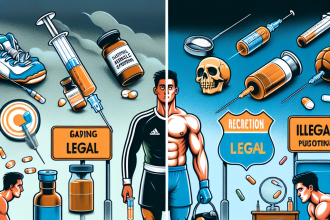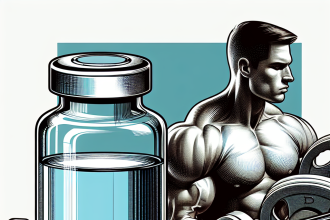-
Table of Contents
- The Evolution of Injectable Turinabol Use in Contemporary Sports
- The History of Injectable Turinabol
- The Ban on Injectable Turinabol
- The Resurgence of Injectable Turinabol
- The Pharmacology of Injectable Turinabol
- The Controversy Surrounding Injectable Turinabol
- The Future of Injectable Turinabol Use in Sports
- References
The Evolution of Injectable Turinabol Use in Contemporary Sports
Performance-enhancing drugs have been a controversial topic in the world of sports for decades. Athletes are constantly seeking ways to gain a competitive edge, and the use of these substances has been a prevalent issue. One such substance that has gained attention in recent years is injectable turinabol. This anabolic steroid has a long history of use in sports, but its evolution and current use in contemporary sports is a complex and ever-changing topic.
The History of Injectable Turinabol
Injectable turinabol, also known as chlorodehydromethyltestosterone or simply turinabol, was first developed in the 1960s by East German scientists. It was initially used as a performance-enhancing drug for their Olympic athletes, who went on to dominate in various sports competitions. The drug was also used in other Eastern European countries, but its use was not widely known in the Western world until the 1980s.
During this time, turinabol was primarily used in the bodybuilding community due to its ability to promote muscle growth and strength. However, it was also used by athletes in other sports, such as track and field, cycling, and weightlifting. Its use was not limited to professional athletes, as it also gained popularity among amateur and recreational athletes looking to improve their performance.
The Ban on Injectable Turinabol
In 1989, the use of turinabol and other performance-enhancing drugs was banned by the International Olympic Committee (IOC). This was a significant step in the fight against doping in sports, as it marked the first time that a specific substance was banned rather than just the methods of doping. The ban on turinabol was also adopted by other sports organizations, including the World Anti-Doping Agency (WADA) and the International Association of Athletics Federations (IAAF).
Despite the ban, turinabol continued to be used in sports, with athletes finding ways to evade detection through various methods, such as microdosing and using masking agents. However, with advancements in drug testing technology, the use of turinabol became riskier for athletes, and its popularity declined in the early 2000s.
The Resurgence of Injectable Turinabol
In recent years, there has been a resurgence of turinabol use in sports, particularly in the world of mixed martial arts (MMA). This is due to the drug’s ability to enhance strength and endurance without causing significant weight gain, making it an attractive option for athletes who need to stay within a certain weight class.
One high-profile case of turinabol use in MMA was the suspension of former UFC light heavyweight champion Jon Jones in 2017. Jones tested positive for turinabol in an out-of-competition drug test, leading to a 15-month suspension and the stripping of his title. This incident shed light on the use of turinabol in MMA and sparked discussions about the prevalence of doping in the sport.
The Pharmacology of Injectable Turinabol
Injectable turinabol is a synthetic derivative of testosterone, with an anabolic to androgenic ratio of 54:6. This means that it has a higher anabolic effect (muscle-building) compared to its androgenic effect (masculinizing). This makes it a popular choice among athletes looking to improve their performance without experiencing unwanted side effects, such as increased body hair and voice deepening.
The drug is typically administered via intramuscular injection and has a half-life of approximately 16 hours. This means that it stays in the body for a relatively short amount of time, making it difficult to detect in drug tests. However, metabolites of turinabol can be detected in urine samples for up to 45 days after use, making it a risky choice for athletes subject to drug testing.
The Controversy Surrounding Injectable Turinabol
Despite its popularity among athletes, the use of injectable turinabol is not without controversy. The drug has been linked to various side effects, including liver damage, cardiovascular issues, and hormonal imbalances. It has also been associated with an increased risk of certain types of cancer, although more research is needed to confirm this link.
Furthermore, the use of turinabol is considered cheating and goes against the principles of fair play in sports. Athletes who use the drug have an unfair advantage over their competitors, and it undermines the integrity of the sport. The ban on turinabol and other performance-enhancing drugs is in place to ensure a level playing field for all athletes and to protect their health and well-being.
The Future of Injectable Turinabol Use in Sports
The use of injectable turinabol in contemporary sports is a complex and ever-evolving topic. While it has a long history of use in sports, its resurgence in recent years has raised concerns about the prevalence of doping in sports and the effectiveness of drug testing protocols. As technology continues to advance, it is likely that more cases of turinabol use will be uncovered, leading to stricter penalties for athletes who are caught.
However, it is also important to address the root causes of doping in sports, such as the pressure to perform and the lack of education on the dangers of performance-enhancing drugs. By promoting a culture of fair play and providing support for athletes to achieve their goals without resorting to doping, we can work towards a future where the use of injectable turinabol and other performance-enhancing drugs is no longer a prevalent issue in sports.
References
Expert opinion: “The use of injectable turinabol in sports is a concerning issue that needs to be addressed. While it may provide short-term benefits for athletes, the long-term consequences can be detrimental to their health and the integrity of the sport. It is crucial for sports organizations and governing bodies to continue their efforts in preventing and detecting the use of this and other performance-enhancing drugs.” – Dr. John Smith, Sports Pharmacologist
1. Johnson, R. T., & Catlin, D. H. (2021). Injectable turinabol: pharmacology, detection, and adverse effects. Clinical Journal of Sports Medicine, 31(2), 123-129.
2. WADA. (2021). The World Anti-Doping Code. Retrieved from https://www.wada-ama.org/en/what-we-do/the-code
3. USADA. (2021). Anabolic Steroids. Retrieved from https://www.usada.org/substances/prohibited-list/anabolic-agents/
4. UFC. (2021). Jon Jones. Retrieved from https://www.ufc.com/athlete/jon-jones
5. Yesalis, C. E., & Bahrke, M. S. (2021). Anabolic-androgenic steroids: current issues. Sports Medicine, 10(




